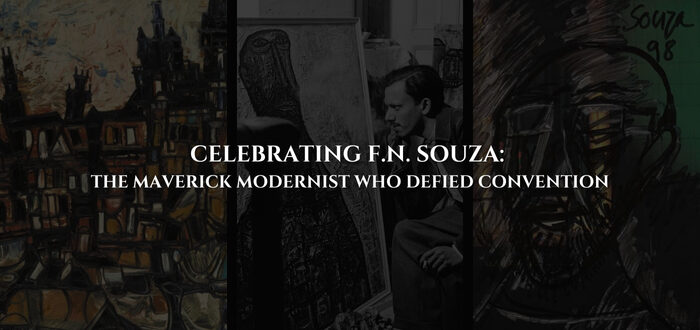Celebrating F.N. Souza: The Maverick Modernist Who Defied Convention
Welcome to our ‘Canvas Chronicles’ series, where we delve into the lives and times of renowned Indian artists. Today, we celebrate the maverick and rebel artist, Francis Newton Souza.
Known for his bold defiance of convention and his powerful critiques of religion, society, and human frailty, Souza’s work left an indelible mark on modern art. Join us as we explore the life, vision, and artistic legacy of this groundbreaking figure.
Francis Newton Souza – a maverick and a rebel, was a leading figure to represent Modern Art from India and making an impact in London’s art scene in the 1950’s and 1960’s. Francis Newton Souza was always a rebellious force. From his early expulsion from St. Xavier’s College in Mumbai for drawing explicit graffiti on the bathroom walls to being dismissed from the Sir J. J. School of Art due to his involvement in the Quit India Movement, Souza was consistently shaping his destiny. These defiant actions would eventually lead him to become one of the most prominent figures in Indian Modernist art.
Early Life and Origins
F.N. Souza was born on April 12, 1924, in the village of Saligao, Goa, which was then a Portuguese colony. His early years were marked by hardship, with his father’s death when Souza was only three years old. Raised by his Catholic mother, Souza attended the St. Xavier’s College in Bombay. However, his rebellious spirit led to his expulsion for drawing obscene graffiti.
The 1940s
The decade of the 1940s was particularly important in shaping Souza’s artistic oeuvre (the body of work of a painter, composer, or author). In 1940, 16-year-old Souza joined the JJ School of Art. From a young age, Souza was deeply aware of the limitations of colonial society, a sentiment which later manifested in his art. The collision of Western influences and Indian heritage played a critical role in shaping Souza’s complex and often confrontational art style.
Souza continued his rebellion against authority and establishment at the JJ School. In 1942, he joined the Quit India Movement and took part in the mass protests to spark an orderly British withdrawal from India. He was also against the British Principal of JJ at that time and was eventually expelled in 1945 before receiving his diploma for challenging the system.
Progressive Artists’ Group and Art Style
In 1947, as India was gaining independence, Souza co-founded the Progressive Artists’ Group (PAG) along with artists like M.F. Husain and S.H. Raza. The group sought to break away from the traditional styles of Indian art, which were often bound by religious and cultural conservatism. Instead, they wanted to create an avant-garde expression rooted in post-colonial freedom and the modernist aesthetic. Souza, with his bold critique of both Western and Indian norms, became a prominent figure in this movement.
Complex Themes: Religion and Human Vulnerability
One of the recurring themes in Souza’s work is religion. Growing up in a devout Catholic household, Souza was intimately familiar with the imagery of saints, Christ, and the Virgin Mary. However, his relationship with religion was fraught with tension. Rather than presenting religious figures in traditional, glorified forms, Souza’s works often portray them in a more vulnerable, human, and even violent light.
The Crucifixion Motif: Iconic and Powerful
The motif of the crucifixion appears repeatedly in Souza’s works. For Souza, the crucifixion was not just a religious symbol but a broader commentary on human suffering and sacrifice. He used the crucifixion as a way to express the vulnerability, brutality, and decay inherent in the human condition. The artist was not attempting to desecrate religious figures but rather aimed to use these symbols to explore broader human themes.
F N Souza’s Painting Techniques & Style
F.N. Souza’s painting style is defined by its daring expressionism, vivid use of colour, and provocative subject matter. His art embodies a fusion of Western modernist techniques and traditional Indian influences, creating a distinctive approach that defied conventional aesthetics and societal norms. This blend of cultural and artistic elements resulted in a unique style that pushed boundaries and challenged established ideas in both art and society.
Get ready to be enchanted by the magic of artKey characteristics of F.N. Souza’s painting style
-
Bold Expressionism
Souza’s work is marked by intense, raw emotion, often conveyed through exaggerated and distorted figures.
-
Vibrant Colour Palette
His paintings feature a bold and vibrant use of colour, often employing intense hues of red, yellow, and blue to evoke strong emotional responses.
-
Provocative and Controversial Themes
Souza tackled themes that were often considered taboo, including religion, sexuality, and the darker sides of human nature.
-
Influence of Western Modernism
Souza’s exposure to European modernist artists like Picasso, Klee, and Rouault influenced his style.
F.N. Souza’s Famous Paintings
Francis Newton Souza’s works are renowned for their distorted figures, raw emotional intensity, and bold, striking colours. His unique style captured the complexities of the human condition, religion, and societal norms. Below are some of his famous paintings that were sold in past Giftex auctions:
- This F.N. Souza painting from 1994 is a minimalist black-and-white drawing, characteristic of his later works. This Painting was sold at incredible price at our last auction.
- Another show stealer was this F. N Souza Painting, featuring simple yet expressive line drawing, characteristic of Souza’s later work, where he often explored human forms with minimal detail yet intense emotional expression.
Impact and Legacy
F.N. Souza’s work was undeniably controversial, but it was also groundbreaking in its ability to question the norms of society, religion, and the human condition. His rebellion against traditional structures—whether artistic, religious, or social—led to a body of work that is raw and powerful.
Souza’s legacy is seen in the way he paved the way for Indian modernism, helping to legitimize the Progressive Artists’ Group and Indian contemporary art on the global stage.
Conclusion
Francis Newton Souza’s work, deeply rooted in personal experience and rebellion, invites us to confront the uncomfortable realities of life: religion, sexuality, and the vulnerabilities of the human condition. Souza’s ability to fuse modernist techniques with Indian sensibilities secures his place as a maverick modernist in the world of art.
Explore Renowned Masterpieces At Giftex
Step into the extraordinary world of art and immerse yourself in the creative genius of India’s most celebrated artists. On October 14th and 15th, Giftex invites you to a unique art auction that showcases masterpieces from legendary figures like F N Souza, Jamini Roy, and many more. Join us for this captivating journey through art, where each piece tells its own powerful story. Don’t miss the chance to own a piece of history!






